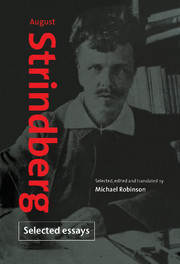Book contents
- Frontmatter
- Contents
- Notes on the text
- Introduction
- from Vivisections (1887)
- ‘On Modern Drama and Modern Theatre’ (1889)
- from Vivisections II (1894)
- ‘I’
- ‘The Making of an Aspasia’
- ‘Nemesis Divina (Cont.)’
- ‘The New Arts! or The Role of Chance in Artistic Creation’
- ‘Whence We Have Come’
- ‘Character a Role?’
- ‘Césarine’ (1894)
- ‘Deranged Sensations’ (1894)
- ‘In the Cemetery’ (1896)
- from Jardin des Plantes (1896)
- ‘On the Action of Light in Photography’ (1896)
- ‘A Glance into Space’ (1896)
- ‘Edvard Munch's Exhibition’ (1896)
- ‘The Synthesis of Gold’ (1896)
- ‘Contemporary Gold-Making’ (1896)
- ‘The Sunflower’ (1896)
- ‘The Mysticism of World History’ (1903)
- ‘August Strindberg on Himself’ (1909)
- Notes and commentary
- Index
‘The New Arts! or The Role of Chance in Artistic Creation’
Published online by Cambridge University Press: 18 December 2009
- Frontmatter
- Contents
- Notes on the text
- Introduction
- from Vivisections (1887)
- ‘On Modern Drama and Modern Theatre’ (1889)
- from Vivisections II (1894)
- ‘I’
- ‘The Making of an Aspasia’
- ‘Nemesis Divina (Cont.)’
- ‘The New Arts! or The Role of Chance in Artistic Creation’
- ‘Whence We Have Come’
- ‘Character a Role?’
- ‘Césarine’ (1894)
- ‘Deranged Sensations’ (1894)
- ‘In the Cemetery’ (1896)
- from Jardin des Plantes (1896)
- ‘On the Action of Light in Photography’ (1896)
- ‘A Glance into Space’ (1896)
- ‘Edvard Munch's Exhibition’ (1896)
- ‘The Synthesis of Gold’ (1896)
- ‘Contemporary Gold-Making’ (1896)
- ‘The Sunflower’ (1896)
- ‘The Mysticism of World History’ (1903)
- ‘August Strindberg on Himself’ (1909)
- Notes and commentary
- Index
Summary
They say that the Malays make holes in the bamboo stems that grow in their forests. When the wind comes the savages lie on the ground and listen to symphonies performed by these gigantic Aeolian harps. The strange thing is that each man hears his own melody and harmony, just as the wind blows.
Weavers are known to employ the kaleidoscope to discover new designs, leaving it to blind chance to assemble the bits of coloured glass.
On arriving at the well-known artist's colony at Marlotte, I went into the dining room to look at the celebrated painted panels. There I saw a portrait of a woman: α) young, β) old, etc. Three crows on a branch. Very well executed. What it represents is immediately apparent. Moonlight. A rather bright moon; six trees; still water with reflections. Moonlight, of course!
But what is it? – It is precisely this initial question that affords the first pleasure. There is a need to search, to conquer; and nothing is more delightful than when the imagination is set in motion.
What is it? Painters call it ‘palette scrapings’, which means that when an artist has finished working, he scrapes the remnants of the colours together, and if he feels so inclined, uses them to make a rough sketch. I stood enraptured before this panel at Marlotte. The colours possessed a harmony that was, of course, readily explained by their having all been part of the same painting.
- Type
- Chapter
- Information
- August Strindberg: Selected Essays , pp. 103 - 107Publisher: Cambridge University PressPrint publication year: 1996
- 1
- Cited by



